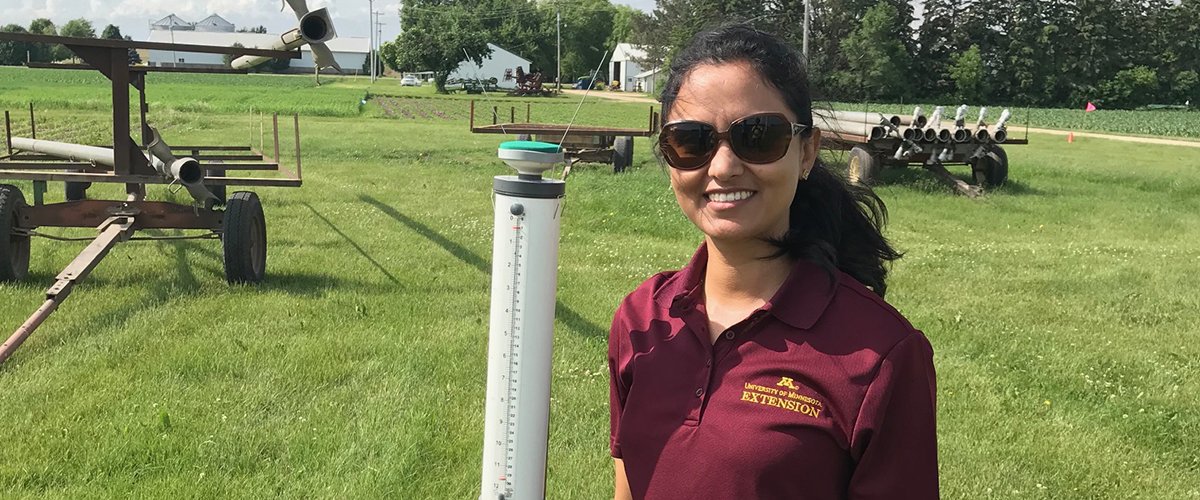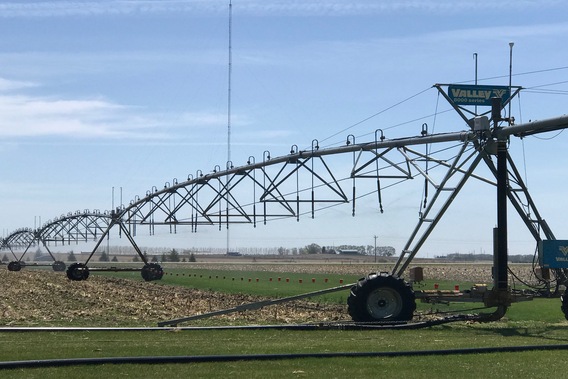
Behind the research: Maximizing harvests with smart irrigation and nitrogen fertilization techniques
Researcher Vasu Sharma discusses her team's research on corn crops in Minnesota

Vasu Sharma, PhD, conducts research at the Sand Plain Research Farm exploring the optimal levels of irrigation and nitrogen usage for corn crops. She focuses on developing practical and cost-effective solutions that can be widely adopted by farmers to help them make decisions about crop inputs and yield impact. Sharma and her team deploy cutting-edge technology like satellites and sensors to discover ways to optimize crop yield while minimizing resource usage and environmental impact that will have important implications for the agriculture industry as a whole. We sat down with Sharma to learn more about her research and impact.
What inspired you to research corn growth and its relation to nitrogen and irrigation rates?

Water resource management is currently among the most urgent agricultural issues across the globe. Fragile systems are at risk of losing access to their already precarious water resources as the climate continues to change and affect air and weather conditions worldwide. It’s critical for us to conduct concentrated studies on cutting-edge water management techniques to safeguard populations from the risks of water scarcity and catastrophic disasters. The environmental effects of irrigated agriculture on groundwater have been, and continue to be, a major concern in the upper midwestern region of the U.S., particularly Minnesota. High rates of groundwater withdrawal — the process of extracting water from an aquifer — for irrigation can create water quality issues in nearby lakes and streams, and nitrate leaching into groundwater due to over-irrigation contaminates drinking water for communities surrounding agricultural production. Corn is grown on almost half of the land that gets irrigated in Minnesota. But growing corn requires a lot of nitrogen and water, causing pollution in nearby lakes and streams and even the drinking water for people who live by farms. This motivated me to research corn growth and its relation to nitrogen and irrigation rates as it is a significant challenge among farmers to optimize nutrient management and reduce water usage. I wanted to find a way to maximize yields and crop quality while maintaining sustainability.
Can you explain the methodology you used to conduct the research?
We’ve set up a study on a small plot of land to test out different irrigation and nitrogen rates. To collect real-world data on how water and nitrogen are moving through the soil, we use advanced techniques and technology. This includes soil moisture sensors, proximal sensors, and unmanned aerial vehicles to get a better understanding of how everything is working. We also use remote sensing and lysimeters to gather even more data. This data will help us establish better management approaches for both irrigation and nitrogen. In order to correlate the levels of irrigation and nitrogen rate inputs with corn growth and yield, we additionally assess soil residual nitrogen, plant nitrogen uptake during the corn growing season, and corn growth and yield. Our overall goal is to evaluate the effects of varying irrigation and nitrogen rates on corn yield, nitrate leaching, crop evapotranspiration, crop water productivity, and water- and nitrogen-use efficiency; and to develop non-destructive in-season corn water and nitrogen status diagnosis methods based on remote sensing.
What were some of the key findings from your research on corn growth and nitrogen/irrigation rates?
Although this research is still in progress, the first three years' worth of data indicates that an ideal balance of nitrogen and irrigation rates is crucial for optimum corn growth and quality, with a surplus of either resulting in both reduced crop quality and yield. Reduced or limited irrigation is preferable to a full irrigation strategy, especially in years with heavy or average precipitation, as it aids in large reductions in nitrate leaching.
How can this research benefit farmers and government organizations?
Our main objective is to gather scientific data on irrigation and nitrogen management that can be used to inform government agencies, stakeholders, and producers as they make important crop input decisions. By understanding the fundamental relationship between these factors, we hope to be able to develop policies and rules that promote sustainable farming practices. In addition, we’re also hoping to provide farmers with the information they need to make more informed on-farm management decisions. By utilizing sensor-based irrigation and nitrogen management research, we’re able to gather accurate data that can help farmers optimize crop yields while minimizing their environmental impact.

What future research plans do you have related to sustainability and crop management?
Our continuous effort is to work on finding innovative and novel strategies and technologies for efficient agricultural water and nutrient management. The big idea behind our future research is to use advanced data and new technologies such as UAVs, satellites, remote sensing, artificial intelligence, and machine learning to boost the effectiveness of management that will increase the quality and quantity of production while reducing the environmental impacts and input resources (water and nitrogen).
Sharma’s research is done in collaboration with Fabian Fernandez, PhD, and Yuxin Miao, PhD, of University of Minnesota Extension. Fernandez is a professor and Miao is an associate professor in the Department of Soil, Water and Climate. The Minnesota Corn Growers and the Agricultural Fertilizer Research and Education Council (AFREC) of the Minnesota Department of Agriculture are providing funding for the research.





